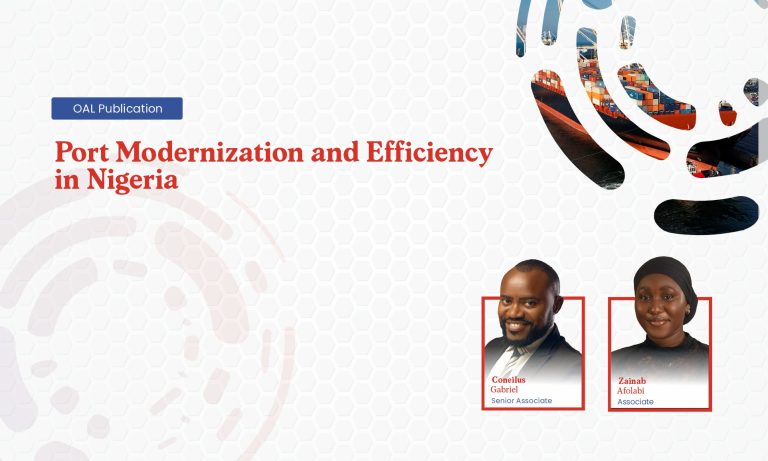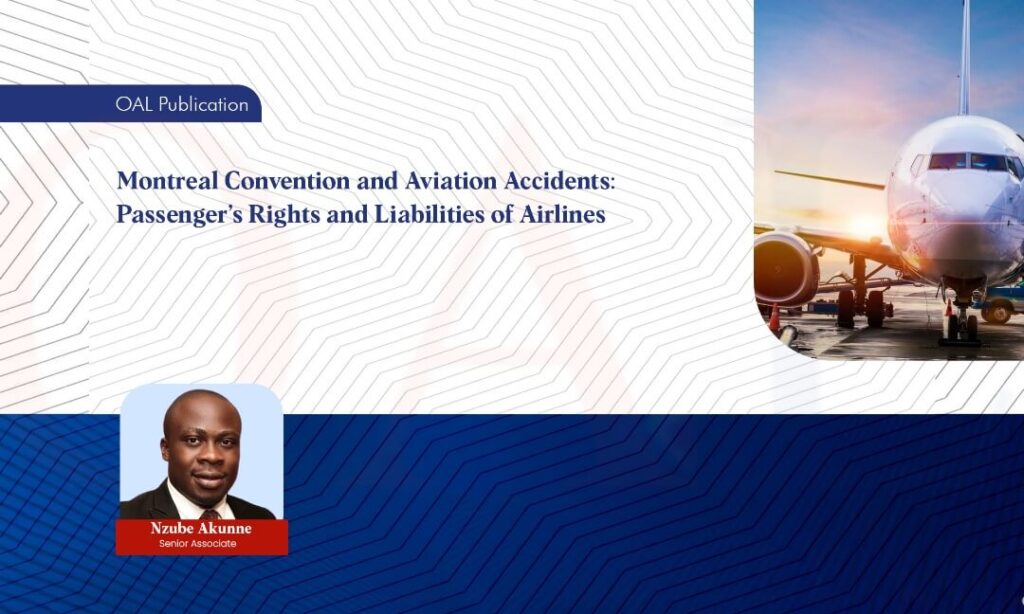
Montreal Convention and Aviation Accidents: Passenger’s Rights and Liabilities of Airlines

Every year, millions of passengers fly via airlines, including transporting goods and mail, trusting in the safety of the aviation sector. While most flights proceed without incident, accidents can happen, especially during the critical stages of boarding (embarkation) and disembarking (leaving) the aircraft. These moments are often overlooked, but they pose significant risks to passengers. The Montreal Convention, an international treaty, is domesticated in the Third Schedule of the Civil Aviation Act Cap. C13 Laws of the Federation of Nigeria 2010, provides vital protection for passengers in such situations.
This article explores how the Montreal Convention, as adopted in Nigeria, defines passenger rights and the liabilities of airlines in case of accidents during these crucial stages of air travel.
AVIATION ACCIDENTS: A GROWING CONCERN
Recent incidents highlight the vulnerabilities passengers face during these critical phases of air travel:
- A Fall on the Stairs: In September 2023, a Spanish court awarded a passenger over €30,000 for injuries sustained after falling on an aircraft staircase while leaving the plane. This highlights the dangers even in seemingly routine procedures.
- Turbulence Tragedy: In June 2024, a Singapore Airlines flight experienced severe turbulence, resulting in a fatality and several injuries. A 73-year-old British man sadly lost his life, while other passengers and crew members sustained skull, brain, and spine injuries. The Boeing 777-300ER, carrying 211 passengers and 18 crew, was diverted to Bangkok for emergency landing and medical attention. Singapore Airlines offered $10,000 in compensation to passengers with minor injuries and higher payouts for those with more severe injuries.
These accidents show just how important the Montreal Convention is! It’s like a big rulebook for flying between countries that tells airlines what they need to do if something goes wrong, and it also tells passengers what they can do to get help if they’re hurt.
LEGAL FRAMEWORK: THE MONTREAL CONVENTION
Article 17 of the Montreal Convention establishes a strict liability of the airline for severe bodily injuries sustained by passengers during embarkation and disembarkation. To establish liability, three conditions must be met:
- Occurrence of an Accident: The event must qualify as an aviation accident under the convention, encompassing unexpected, unusual, and unforeseeable events related to the activity of flying.
- Accident Causes Death or Bodily Injury:A direct causal relationship must exist between the accident and the death or bodily injury of the passenger. Bodily injury refers to any physical injury resulting in a change of the human body, such as broken bones, strained muscles, or cuts. Therefore, it can be deduced that mental injuries like Psychic, emotional problems, fears, mental injuries, behavioural problems or traumas that do not involve direct bodily injury, shall not qualify as accidents.
- Accident Takes Place on Board or During Operations: The accident must occur either on board the aircraft or during the operations of embarking or disembarking. Embarkation begins when the passenger is under the airline’s charge and follows their instructions, while disembarkation ends when the passenger leaves the airport building and is no longer under airline surveillance.
The Montreal Convention mostly focuses on physical injuries. It’s usually used when someone is hurt physically. However, some courts think that really serious mental problems caused by things like sexual harassment, terrorist attacks, or extreme weather on a plane could also be considered accidents.
Also read: Urgent Need for a Local Content Policy in the Aviation Industry in Nigeria
Defining an “Aviation Accident”
Defining “aviation accident” is crucial, and several case laws have established its interpretation:
- Qualifying Events: Aviation accidents include unexpected events related to flying that result in passenger death or bodily injury.
- Non-Qualifying Events: The convention does not consider events like tripping on hand luggage, injuries caused by adjustable seats, communication issues, food allergies, or health-related problems experienced by passengers as aviation accidents.
- Passenger Negligence: If an injury occurs due to a passenger’s negligence despite the airline taking necessary precautions, the airline may not be liable.
Determining “Embarkation” and “Disembarkation”
The convention does not define “embarking” and “disembarking,” leaving their interpretation to the courts. However, given that Nigeria has a common law background, the courts will normally look to see how other common law countries have decided the question and this will provide persuasive authority whenever the court is called upon to determine the question.
In determining the purpose of “embarking” and “disembarking” under Article 17. Judicial authorities have examined the issue focus on several factors:
- Passenger Activity: The passenger’s actions at the time of the injury.
- Movement Restrictions: Whether the passenger’s movement was restricted.
- The imminence of Boarding: How close the passenger was to actual boarding.
- Physical Proximity to the Gate: The passenger’s physical proximity to the gate.
The courts say you have to be close to the plane (both in distance and time) for something to count as an accident that happened “on the plane” or “getting on/off the plane.” The examples show that even being on a step stool near the plane or on an escalator right after landing is still considered part of getting off the plane.
See Ramos v. Am. Airlines, Inc., 2011 WL 5075674 (W.D.N.C. Oct. 25, 2011) and Day v. Trans World Airlines, Inc., 528 F. 2d 31, 33–34 (2d Cir. 1975).
When it comes to deciding if someone was “embarking” or “disembarking” for legal purposes, courts are pretty strict. They want to see that the person was very close to the plane, both in terms of location (space) and time. They have to be right there, about to get on or off the plane, for the court to consider them in that stage of travel.
See Fedelich v. Am. Airlines, 724 F. Supp. 2d 274 (D.P.R. 2010). In Walsh v. Koninklijke Luchtvaart Maatschappij N.V. [2011] WL 4344158, at 3 (S.D.N.Y. Sept. 12, 2011)., the court found that a passenger who tripped and fell on a low lying metal bar near the departure gate was “embarking” at the time of his injury. The court explained that, if someone is walking toward the gate, getting ready to board their flight. They haven’t given their boarding pass yet, but they’re heading in that direction, joining the other people waiting to board. They trip on something near the gate and get hurt. Even though they weren’t officially on the plane yet, the court said they were already “embarking” because they were clearly on their way to get on the plane.
See Findlay v. Alaska Air Group, Inc., 2011 WL 2710499 (D.Nev. July 12, 2011). “In a court case called Fedelich v. American Airlines, 724 F. Supp. 2d 274, 284 (D.P.R. 2010), the judge said that ‘disembarking’ simply means getting off the aeroplane.
The Court in Ugaz v. Am. Airlines, Inc., 576 F. Supp. 2d 1354 (S.D. Fla. 2008), held that a passenger who fell while using a broken escalator right after their plane landed was still considered to be disembarking. This means the airline was still responsible because the passenger was following their instructions and going where they were told to go (towards customs and immigration).
Defences to Aviation Accidents
It can be argued in some instances with reliance on Article 21 [2] of the Montreal Convention that the damage was not due to the negligence or other wrongful act of the Airline or its servants or agents and that the damage was solely due to the negligence or other wrongful act or omission of a third party. It appears that a third party’s interference does not take away the strict liability of Air Carriers under the Montreal Convention. It also appears that the issue of Negligence and omission or whether the Air Carrier was guilty of negligence and or willful misconduct under Article 25 of the Montreal Convention or had exercised reasonable care under Article 20 of the Montreal Convention can be determined by the Court in line with the facts of the case.
Although, the provisions of Article 21 of the Montreal Convention have not been tested in the Nigerian courts. However, the court decisions where the question of ‘willful misconduct’ has been considered suggest the application of a subjective standard in determining whether an act or omission will be considered as ‘willful misconduct’. In Harka Air Services (Nig) Ltd v Keazor (2011) 6 KLR (Pt.298) 1771 at 1786, the court upheld the findings of a Federal High Court and the Court of Appeal that the airline was guilty of willful misconduct for taking off for flight during bad weather.
Therefore, how the court will interpret and apply the ‘no negligence’ and omission defence under Article 21 of the Montreal Convention, and other provisions like the strict liability of the Air Carrier under Article 17 [1] of the Montreal Convention; the ‘all reasonable measures’ in Article 20 of the Montreal Convention and the ‘willful misconduct’ standard of Article 25 of the Montreal Convention can only be determined by the facts of the case.
Passenger Rights and Compensation
The Montreal Convention grants passengers the right to compensation for injuries sustained during embarkation and disembarkation. This compensation may include medical expenses, lost wages, and pain and suffering. The convention also sets limits on compensation amounts, which can be adjusted by national legislation.
The Role of Nigerian Law in Implementing the Montreal Convention
Nigeria has domesticated the Montreal Convention through its Civil Aviation Act, making its provisions enforceable in Nigerian courts. This integration provides a legal foundation for passengers to pursue claims for compensation.
Conclusion
The Montreal Convention provides passengers with crucial protection in case of accidents during boarding and leaving an aircraft. Understanding your rights and the responsibilities of airlines under this important treaty can help you navigate a difficult situation if an accident occurs.
So, what does this all mean? Basically, if you’re an international passenger and you get hurt or worse, even if it’s just mental distress, because of an accident while getting on or off the plane, you can ask for money from the airline. But the most you can get is $100,000, under the Modification to the Convention for the Unification of Certain Rules relating to International Carriage by Air [The Montreal Convention] as domesticated in the Third Schedule of the Civil Aviation Act Cap. C13 Laws of the Federation of Nigeria 2010.
Remember, airlines are generally held strictly liable for accidents, but there are some defenses that can be raised. If you are injured during embarkation or disembarkation, seek legal advice to understand your rights and how to pursue compensation.
Contributor





